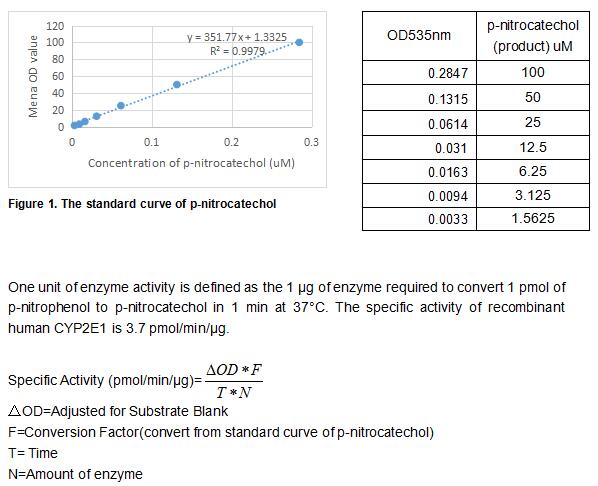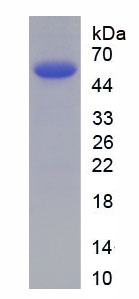Active Cytochrome P450 2E1 (CYP2E1) 

CPE1; CYPIIE1; P450-J; P450C2E; 4-nitrophenol 2-hydroxylase; Cytochrome P450 Family 2 Subfamily E 1; Cytochrome P450,Subfamily IIE(Ethanol-Inducible)Polypeptide 1
Overview
Properties
- Product No.APA988Hu01
- Organism SpeciesHomo sapiens (Human) Same name, Different species.
- ApplicationsCell culture; Activity Assays.
Research use only - DownloadInstruction Manual
- CategorySignal transductionMetabolic pathway
- Buffer FormulationPBS, pH7.4, containing 0.01% SKL, 5% Trehalose.
- Traits Freeze-dried powder, Purity > 90%
- Isoelectric Point9.3
Sign into your account
Share a new citation as an author
Upload your experimental result
Review

Contact us
Please fill in the blank.
Activity test

The cytochrome P450 enzyme CYP2E1 catalyzes the oxidative metabolism of many solvents and other small organic molecules. CYP2E1 is expressed in adult and fetal human liver in addition to extrahepatic tissues such as lung and placenta. Treatment of primary cultures of human hepatocytes with ethanol induces CYP2E1 protein, and this is consistent with the finding that hepatic CYP2E1 protein and mRNA levels are increased in individuals with alcoholism. Although only a few drugs (e.g., acetaminophen have been identified as substrates for CYP2E1, many low molecular weight procarcinogens are activated by this cytochrome P450 (P450). Chlorzoxazone 6-hydroxylation, N-nitrosodimethylamine N-demethylation and p-nitrophenol hydroxylation can be used to measure the catalytic activity of CYP2E1. Thus, the recombinant human CYP2E1 activity was measured by its ability to hydroxylate p-nitrophenol to p-nitrocatechol. The reaction was performed in 50 mM potassium phosphate, pH 7.4 ( Assay Buffer), initiated by addition 20 μL of 500 ug/ml CYP2E1 to 10 µL of 5 mM substrate p-nitrophenol and 30 ul of 26 mM NADPH in a total volume of 500 ul. Incubated at 37 ℃ for 30min, then read at a wavelength of 535 nm after acidification of the reaction mixture with trichloroacetic acid followed by neutralization using 2 M NaOH.
Usage
Reconstitute in 10mM PBS (pH7.4) to a concentration of 0.1-1.0 mg/mL. Do not vortex.
Storage
Avoid repeated freeze/thaw cycles. Store at 2-8°C for one month. Aliquot and store at -80°C for 12 months.
Stability
The thermal stability is described by the loss rate. The loss rate was determined by accelerated thermal degradation test, that is, incubate the protein at 37°C for 48h, and no obvious degradation and precipitation were observed. The loss rate is less than 5% within the expiration date under appropriate storage condition.
Increment services
-
 BCA Protein Quantification Kit
BCA Protein Quantification Kit
-
 Molecular Mass Marker for Protein
Molecular Mass Marker for Protein
-
 Monoclonal Antibody Customized Service
Monoclonal Antibody Customized Service
-
 Polyclonal Antibody Customized Service
Polyclonal Antibody Customized Service
-
 Protein Activity Test Experiment Service
Protein Activity Test Experiment Service
-
 Electrophoretic Mobility Shift Assay (EMSA) Experiment Service
Electrophoretic Mobility Shift Assay (EMSA) Experiment Service
-
 Buffer
Buffer
-
 Lentivirus Packaging Experiment Service
Lentivirus Packaging Experiment Service
-
 Adenovirus Packaging Experiment Service
Adenovirus Packaging Experiment Service
-
 Real Time PCR Experimental Service
Real Time PCR Experimental Service
-
 Spike RBD Protein (S-RBD)
Spike RBD Protein (S-RBD)
-
 Protein G
Protein G
-
 Protein A
Protein A
Citations
- Hepatoprotective effect of ethanolic extract of Curcuma longa on thioacetamide induced liver cirrhosis in ratsPubMed: PMC3605171
- Mechanism of Hepatoprotective Effect of Boesenbergia rotunda in Thioacetamide-Induced Liver Damage in RatsPubMed: PMC3749608
- CCl4-induced hepatotoxicity: protective effect of rutin on p53, CYP2E1 and the antioxidative status in ratPubMed: PMC3519517
- Hepatoprotective Effect of Methanolic Stem Extract of Bush Cane (Costus Afer) on Immunologic Response Generated Reactive Oxygen Species (ROS) in Alcohol Induced Liver Cirrhosis in Rats. Ajbpr:Source
- Pass-predicted hepatoprotective activity of Caesalpinia sappan in thioacetamide-induced liver fibrosis in ratsPubmed:24701154
- Protective effect of Djulis (Chenopodium formosanum) and its bioactive compounds against carbon tetrachloride-induced liver injury, in vivopublication:307092820
- Haloperidol loaded carboxymethyl chitosan nanoparticles reduce Oxidative stress, Mitochondria dysfunction and DNA damage in hepatic cells of male rats.59f7c85aaca272607e2d8d7a
- Toxicity assessment due to prenatal and lactational exposure to lead, cadmium and mercury mixturesPubmed: 31639605
- Oxidative Stress Parameters in the Liver of Growing Male Rats Receiving Various Alcoholic BeveragesPubmed: 31935882
- Ellagic Acid Prevents Binge Alcohol-Induced Leaky Gut and Liver Injury through Inhibiting Gut Dysbiosis and Oxidative Stress34573017







